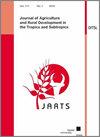肯尼亚东部和沿海地区猴面包树(Adansonia digitata L.)产品的价值链分析
Q3 Social Sciences
Journal of Agriculture and Rural Development in the Tropics and Subtropics
Pub Date : 2019-11-14
DOI:10.17170/KOBRA-20191030732
引用次数: 23
摘要
对来自欧洲和北美的高营养猴面包树果肉日益增长的需求提出了一个问题,即猴面包树产品的营销是否可以成为肯尼亚农村社区的收入来源,或者来自海外的需求增加是否会干扰国内猴面包树的使用。为了了解国内猴面包树的使用情况,采用定性方法对食用猴面包树产品进行了价值链分析。采用非概率抽样法,对134名猴面包树价值链受访者进行了调查,包括从猴面包树产品生产商到零售商的销售数据、数量和利润。另一项家庭调查、关键信息提供者访谈和参与性研究的结果被用来确定猴面包树业务的优势、劣势、机会和威胁。猴面包树价值网络的主要参与者是农民、收集者、批发商、加工商和零售商;72%的受访者是女性。交易最多的产品是未加工的包着纸浆的种子和mabuyu,一种由包着猴面包树纸浆的种子、糖和食用色素制成的糖果。在玛布尤价值链上,产品的平均价值从支付给农民的每公斤原浆覆盖种子的0.07美元增加到最终消费者支付的每公斤玛布尤糖果的1.50美元。对农民来说,收获和交易猴面包树产品是旱季的额外收入来源。猴面包树产品商业化程度的提高和农民更好地融入价值链可能会增加收入,特别是妇女的收入。本文章由计算机程序翻译,如有差异,请以英文原文为准。
A value chain analysis of baobab (Adansonia digitata L.) products in Eastern and Coastal Kenya
A growing demand for the highly nutritious baobab fruit pulp from Europe and North America raises the question whether the marketing of baobab ( Adansonia digitata L.) products could be an opportunity as an income source for rural communities in Kenya, or if the increased demand from overseas would disturb domestic baobab use. To gain an idea of domestic baobab use, a value chain analysis of edible baobab products was performed, using qualitative methods. By using a non-probability sampling, 134 baobab value chain respondents from producers to retailers of baobab products were interviewed on sales data, volumes and profits. Results from an additional household survey, key informant interviews and participatory research were used to identify strengths, weaknesses, opportunities and threats of and to the baobab business. The main actors of the baobab value network were farmers, collectors, wholesalers, processors and retailers; 72% of the respondents were female. The products most traded were unprocessed pulp-covered seeds and mabuyu, a candy made out of baobab pulp-covered seeds, sugar and food colour. The average value of the product along the mabuyu value chain increased from 0.07 USD per kg of raw pulp-covered seeds paid to the farmer to up to 1.50 USD per kg paid by the end consumer for the mabuyu candy. For farmers, the harvesting and trading with baobab products is an additional source of income during the dry season. Increased commercialisation of baobab products and better integration of farmers into value chains may enhance income, particularly of women.
求助全文
通过发布文献求助,成功后即可免费获取论文全文。
去求助
来源期刊
CiteScore
2.30
自引率
0.00%
发文量
0
审稿时长
>36 weeks
期刊介绍:
The Journal of Agriculture and Rural Development in the Tropics and Subtropics publishes papers dealing with original research and review papers in the fields of plant production, animal nutrition and animal husbandry, soil science, rural economy and farm management, forestry and forest economy, veterinary hygiene and protection against epidemics.

 求助内容:
求助内容: 应助结果提醒方式:
应助结果提醒方式:


